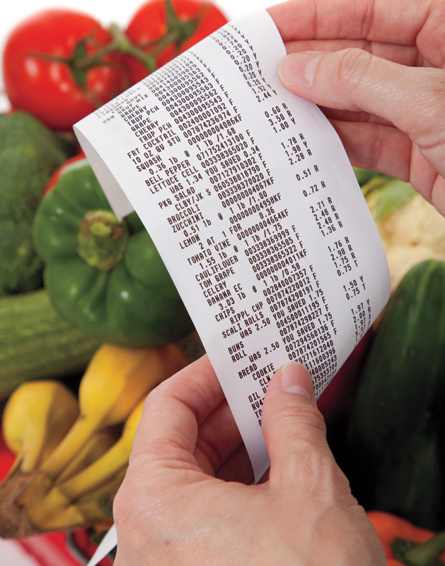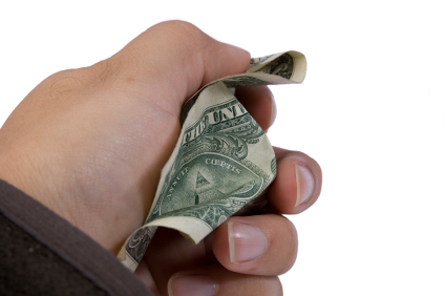Dirty money 2: Expect traces of BPA
Cross contamination from store receipts is suggested as likely source of taint
A fourth small study since June has pointed to an apparent widespread presence of hormone-mimicking bisphenol A in cash-register receipts. Like a Swiss paper last July, the new study found that the potentially toxic chemical can rub off of receipts and onto our fingers. Where the December 8 report breaks new ground is in looking for — and finding — BPA on dollar bills.


Indeed, the pollutant showed up on 21 of the 22 bucks tested. And the clean dollar? It appeared quite new, suggesting that banknotes only become contaminated as they circulate.
The new investigation was performed by the Washington Toxics Coalition in Seattle. Its decision to look at money was prompted by the finding of BPA in a trio of receipts studies last summer. Explains biologist Erika Schreder, the report’s author and a WTC staff scientist, “We knew BPA in receipts is present in a powdery coating, so there was every reason to believe it could come off on money.”
Greenbacks likely acquire their BPA, she says, from receipts-tainted fingers or by money rubbing against receipts in a wallet or pocket. Concentrations found on bills were low, from 0.12 to 11 parts per million. But emerging data on the ubiquity of BPA in receipts, food, kitchenware and more now argue that “even the most careful consumer can’t avoid exposure,” says Schreder.
“Unregulated uses are so pervasive that they’re contaminating money,” she says. “And I wouldn’t be surprised if other things weren’t also contaminated from receipts,” she adds. Like gloves, pockets, wallets, or the papers intermingled with store receipts as tax records.
Taking receipt of BPA
Not surprisingly, WTC turned up massively higher concentrations of BPA in 11 (of 22) store receipts that had used the chemical. The lowest contamination: 8,900 ppm in the receipt issued by a café in the Rayburn House Office building on Capitol Hill. They measured the highest quantity — 22,000 ppm of BPA — in the receipt from a Safeway grocery store in California. BPA constituted a whopping 2.2 percent of that last store receipt.
Thermally printed receipt paper has recently become the norm in many industrial nations. To date, only one American receipt-paper manufacturer — responsible for roughly half of this type of paper in the United States — has switched to a thermal ink that does not rely on BPA. (The Environmental Protection Agency is currently probing the relative safety of alternatives being used by this company and others.)
Because the thermal-ink coating in which BPA resides is essentially a loose powder, there’s nothing to keep it from rubbing off. And rub off it did. Schreder’s group had individuals hold a receipt between their fingers, and that’s all it took to transfer measurable amounts of BPA.
To model real-world exposures, Schreder went to a few stores and timed how long people handle receipts — “which turned out to be around 10 seconds before they put it into their purse, a shopping bag or the trash can.” Because some shoppers handle their receipts substantially more — “crumpling it in their hands or fidgeting with it” — she also assayed BPA’s transfer when people rubbed a receipt between two fingers and their thumb five times.
To Schreder, “The most surprising thing was the amount of BPA that came off on the hands.” Gripping receipts with medium pressure transferred about 1 to 2 micrograms of BPA; fingers picked up 27 to 31 micrograms as they rubbed the paper. Each test was quite limited: two people for each condition studied.
Of course, the big unanswered question is whether BPA’s taint will rub off of banknotes. American greenbacks are notorious for having a fibrous surface in which microscopic contaminants can lodge — potentially locking them up. WTC didn’t test whether rubbing bills would transfer BPA but Schreder says it’s something her team may investigate.
SN reader’s moment of fame
Schreder has not only followed the scientific literature on BPA’s use in receipts but also this blog. She cited and synopsized material from two of my posts in her new report — and even quoted an online commenter to my October 2009 post.
An author of the Swiss BPA-in-receipts study credited that same October post with motivating him to collect store receipts in Europe and see if the contamination was an issue there as well.
So keep those comments coming. They inform and inspire other Science News readers — and may even influence people designing and conducting the next wave of studies.
See also: Dirty money 1: Expect germs





